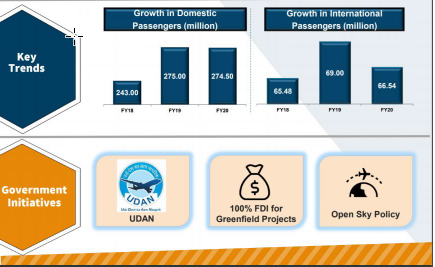
UDAN DAY
Context
- Recently, the Ministry of Civil Aviation has celebrated the UDAN day on the 4th anniversary of the UDAN (Ude Desh Ka Aam Naagrik) Scheme.
- The Government of India has acknowledged the contribution of the scheme and has identified 21st October as UDAN Day, the day on which the scheme document was first released.
ABOUT UDAN SCHEME
- UDAN-RCS, UDAN (Ude Desh ka Aam Naagrik) is a regional airport development and “Regional Connectivity Scheme” (RCS) of Government of India, with the objective of “letting the common citizen of the country fly”, aimed at making air travel affordable and widespread, to boost inclusive national economic development, job growth and air transport infrastructure development of all regions and states of India.
- UDAN is an initiative by the government to connect the country’s under-served and unserved airports.
- While under-served airports are those which do not have more than a flight a day, unserved airports are those where there are no operations.
- The scheme attempts to tackle the issue of ghost airports, it also allows for reduction in travelling expenses. 50 per cent seats on each flight will come at Rs 2,500 per seat for one-hour travel.
- The operators will also be extended viability gap funding which will be operational for three years from the date of starting operations in a specific UDAN route.
CHALLENGES TO AVIATION INDUSTRY
- Pandemic- Covid 19 nearly collapsed aviation industry. National and international flights yet to take off. This is biggest blow to already ailing aviation industry. With global travel restrictions, grounded fleets, benched staff, uncertainties in travel schedule, ticket liabilities, and cash burn, the survival of the aviation sector is in the question of the doubt for even its survival
- Tax on aviation turbine fuel is among the highest in the world – Aviation Turbine Fuel (ATF) is the lifeblood of aviation. Indeed, ATF, or jet fuel, constitutes up to 40 percent of an Indian airline’s cost base and consequently, ends up as one of the largest expense items. Globally, this figure averages roughly 20 percent.
- Constrained runway capacity poses an imminent threat – While shiny new runways have been built, there has been a net addition of only one runway in the last 50 years. The country has a total of 449 airports but metro airports continue to be key to aviation traffic with about 61 percent of the domestic traffic and about 73 percent of international traffic still originating from the six metros — Delhi, Mumbai, Bengaluru, Hyderabad, Kolkata and Chennai.
- The costs of new airport capacity are unrestrained- The funding mechanism of airports is such that the costs of incorrect capacity planning are borne by passengers via development fees. The contribution via fees levied on passengers being 1.2X–1.4X the equity contribution in the case of Delhi and 3.0X–3.2X in the case of Mumbai. This is neither a fair nor a sustainable proposition.
- MRO taxation is forcing airlines to go overseas for maintenance – Other than ATF, the other large expense item for airlines is the maintenance and repair (MRO) of aircraft. Taxation on MRO is irrational at best. Maintenance and repair taxation in India remains the highest globally. With an 18 percent GST levy, providers have to compete on sale price with overseas players that only pay 5 percent — that too at cost price. This gap: 20-22 percent. Consequently, most airlines contract their maintenance overseas, leading to a loss of jobs and output.
SOME MEASURES TAKEN BY THE GOVERNMENT TO SUPPORT THE AVIATION INDUSTRY
- Operation of Regional Connectivity Scheme: UDAN flights were allowed without many restrictions.
- Promoting private investments in existing and new airports through the PPP route.
- Adequate care taken to ensure that cargo terminals at all major airports were operational, whenever required.
- GST rate reduced to 5% for domestic Maintenance, Repair and Overhaul (MRO) services.
- Encouraging Indian carriers to increase their share in international air-cargo traffic.
- Route rationalisation in the Indian airspace in coordination with Indian Air Force for efficient airspace management, shorter routes and reduced fuel burn.
CONCLUSION
- The takeoff of the Indian Airline industry has been delayed unfortunately due to COVID-19. It is expected that the Indian aviation industry to shrink to 2-3 players if they do not receive additional funding. This according to them would result in sustainable damage in connectivity throughout India. This calls for added government focus on the industry in order to ensure that the industry does not suffer irreparable damage.
